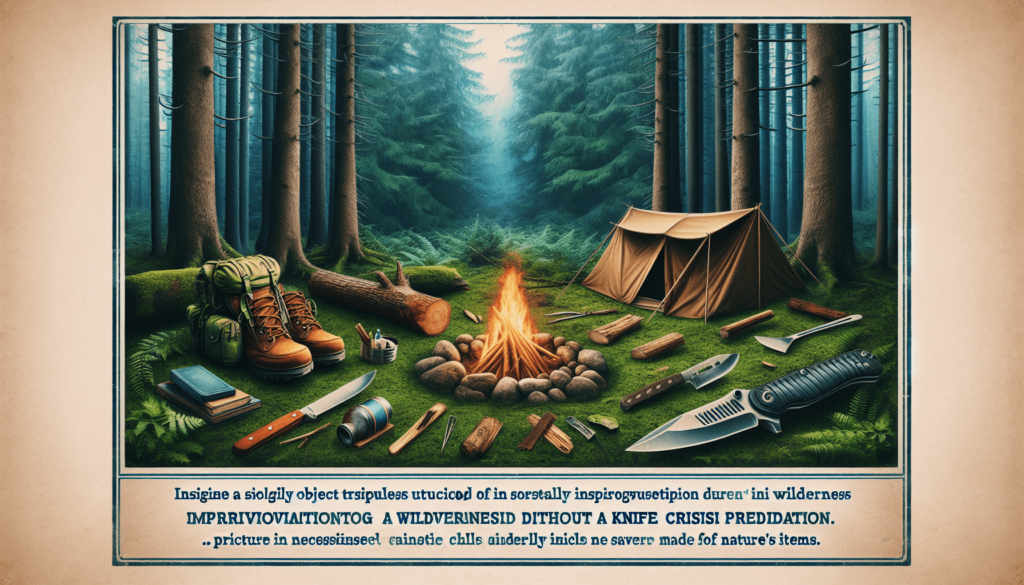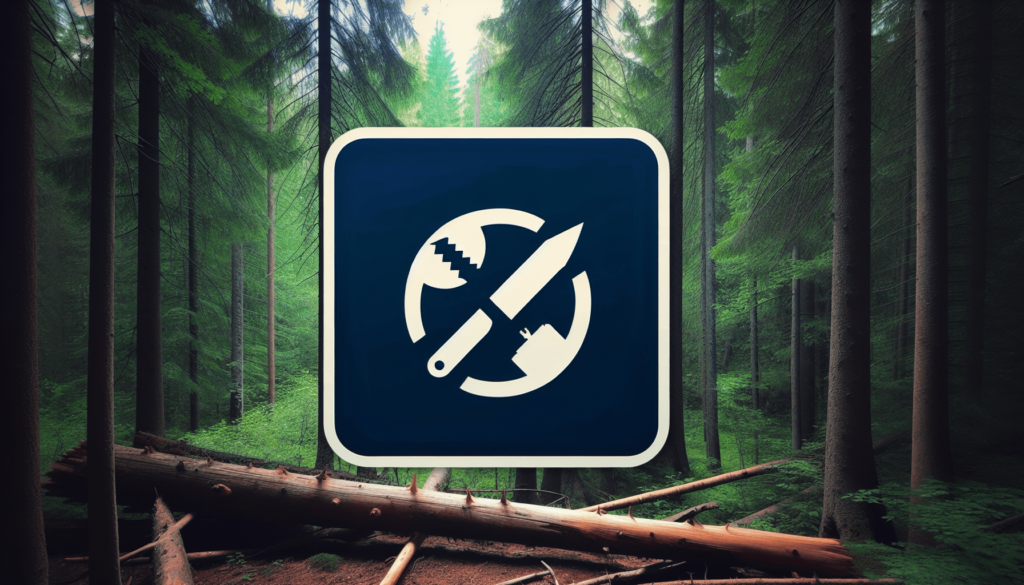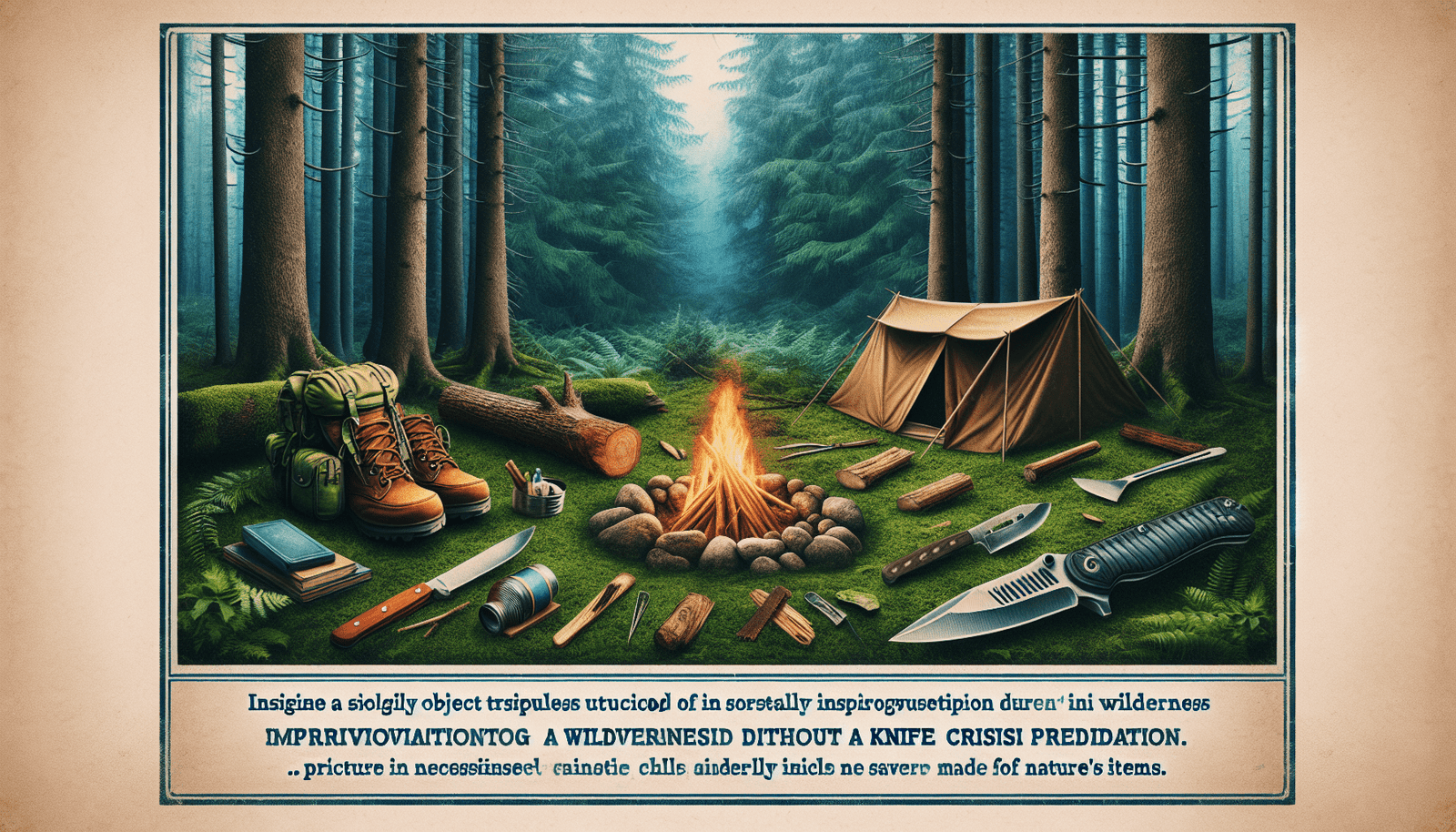Imagine this: you’re deep in the heart of the wilderness, fully immersed in the beauty and tranquility of nature. Suddenly, the unthinkable happens – you lose your knife. Panic sets in as you realize just how dependent you were on that trusty blade. But fear not, my friend, for I am here to guide you through the art of wilderness improvisation when faced with such a crisis. In this article, we will explore ingenious ways to survive without a knife, offering you a glimmer of hope even in the most precarious of situations. So, pack your bags and let’s dive into the world of wilderness survival, where ingenuity and resourcefulness reign supreme.
Heading 1: Assessing the Situation
When you find yourself in a knife crisis in the wilderness, it’s important to remain calm and stay positive. Panicking will only cloud your judgment and hinder your ability to think clearly. Take a deep breath and remind yourself that you have the skills and resourcefulness to overcome this challenge.
The first step is to analyze the loss of your knife. How and when did you lose it? Retracing your steps can help you narrow down the possible locations where the knife might be. If it’s impossible to find or retrieve your knife, it’s time to move on to the next step.
As you evaluate the surrounding environment, keep an eye out for natural alternatives to a knife. Look for sharp stones that you can use to perform basic cutting tasks. Pay attention to any objects in nature that may have sharp edges, such as shells or pieces of broken glass. By being observant and resourceful, you can identify potential solutions even without a knife.
Heading 2: Identifying Natural Alternatives
In the absence of a knife, it becomes essential to identify natural alternatives that can serve as edged tools. One option is to collect sharp stones found in the area. Look for stones with naturally occurring sharp edges or ones that can be shaped into a makeshift cutting tool with some effort. These stones can be used for basic cutting tasks.
Another alternative is to locate and utilize natural objects with sharp edges. For example, shells, broken clamshells, or even seashells can have sharp edges that can help you perform tasks requiring a blade. Just be cautious while handling these objects as they may be fragile.
If you have access to wood or bone, you can also consider crafting spear or arrowheads. Sharpen a suitable piece of wood or bone to create a makeshift cutting tool. While this may require some time and effort, it can provide you with a more versatile tool for various tasks.

Heading 3: Creating Edged Tools from Available Materials
When natural alternatives aren’t readily available, you can create edged tools from the materials around you. One option is to utilize broken glass or metal scraps if you find any in your surroundings. These materials can be sharpened by rubbing them against rocks or hard surfaces to create a rough cutting edge. Exercise caution when handling broken glass to avoid injury.
Another method is to fashion an improvised blade from a broken tool you may have with you. Look for objects like a broken hacksaw or a file, which can be reshaped and sharpened into a usable cutting tool. With some creativity and effort, you can salvage these items and make them functional again.
If you’re unable to find any suitable materials for a blade, consider shaping a survival knife from rock or bone. Look for a sturdy rock or a large bone, and use abrasive surfaces to shape it into a cutting tool. While this method may require more time and effort, it can provide you with a durable and effective blade.
Heading 4: Making Fire and Shelter without a Knife
Having the ability to create fire and shelter is crucial for your survival in the wilderness, even without a knife. One method is to build a fire bow drill using natural materials. Find a suitable branch, a piece of string-like material, and a fire board. By rotating the drill between your hands and applying downward pressure, you can create enough friction to ignite the fire board and produce ember.
Constructing a shelter using branches and natural cordage is another option. Look for sturdy branches to act as the structure of your shelter and use flexible vines or plant fibers as cordage to secure them together. By utilizing different techniques such as lean-to or debris hut, you can create a shelter that provides protection from the elements.
In the absence of a knife, crafting a fire-starter kit from found objects can be helpful. Look for materials like rocks, glass, or metal scraps that can be struck together to create sparks. You can also use natural materials like dry grass, birch bark, or char cloth to catch the sparks and start your fire. A fire-starter kit can be a valuable tool to have in your survival arsenal.

Heading 5: Hunting and Gathering Food
When it comes to procuring food in the wilderness without a knife, you can rely on various methods. One option is to set up natural snares to trap small game. Learn about the different types of snares and their setups, such as the figure-four snare or the paiute deadfall trap. Position them in areas with evidence of animal activity and set them up carefully to improve your chances of a successful catch.
Foraging for edible plants and insects is another viable option. Educate yourself on the local flora and fauna to identify safe-to-eat plants and insects. Look for berries, nuts, or edible leaves. Insects like ants, grasshoppers, and beetles can also be a valuable source of protein. Remember to only consume what you positively identify as safe.
If you have access to bodies of water, improvising hooks and lines for fishing can provide you with a fresh food source. Look for suitable branches or long bones that can be shaped into hooks. Natural cordage or vines can be used as line material. By using bait or attracting fish to your hook, you increase your chances of catching a meal.
Heading 6: Navigating without a Knife
Even without a knife, it’s essential to have the ability to navigate in the wilderness. One method is to use natural landmarks and celestial navigation to determine your direction. Observe prominent features like mountains, rivers, or unique tree formations that can serve as reference points. Additionally, understanding how to utilize celestial bodies, such as the sun or stars, can provide you with a sense of direction.
Creating and following natural trail markers is another useful technique. Look for distinct natural objects like rocks, fallen trees, or unique plant formations that can serve as markers. By leaving your own markers along the way, you can create a trail that is recognizable and easier to follow, even without a knife.
If you have access to magnetized objects, you can also improvise a compass. Find a small metal object like a needle or a soda can tab, magnetize it by rubbing it against a magnet or your clothing, and float it on a leaf in water. The magnetized object will align itself with the Earth’s magnetic field, pointing north and south, helping you navigate.
Heading 7: Improvising First Aid Solutions
In a survival situation, being able to provide basic first aid is crucial. Without a knife, improvising solutions becomes necessary. For creating bandages and splints, you can use clothing or natural materials like plant fibers or animal skins. Rip or tear clothing or fabric into strips and use them to secure wounds or support injured limbs.
Heat and pressure can be utilized to treat injuries. For example, you can heat rocks near a fire and wrap them in cloth to create makeshift hot packs. Apply these warm packs to sore muscles or injuries to provide relief and promote healing. Similarly, firm pressure with a cloth or a bandage can help control bleeding from wounds.
Identifying and utilizing natural antiseptics can help prevent infection. Look for plants like yarrow, plantain, or comfrey that have natural antibacterial properties. Crush the leaves and apply the juice or poultice to wounds or cuts as a makeshift antiseptic. Nature provides many resources that can aid in your first aid efforts.
Heading 8: Signaling for Rescue
When you find yourself in need of rescue without a knife, signaling becomes paramount. Creating visible signals is essential, and you can use mirrors or reflective objects to catch the attention of search parties or aircraft. Position yourself in an open area and reflect the sunlight onto the intended target, ensuring that your signal is as visible as possible.
Constructing audible signals can also aid in attracting attention. Whistles or natural materials like hollowed-out branches can help produce loud, attention-grabbing sounds. Use these tools in short bursts or patterns to create recognizable signals that can be easily distinguished from natural sounds.
Using smoke or fire to attract attention is another effective technique. Build a smoky fire using damp leaves or green vegetation, creating a thick and visible plume of smoke. Position the fire in an open area and ensure it is safely contained. The contrast of the smoke against the natural environment can catch the attention of potential rescuers.
Heading 9: Mental and Emotional Resilience
Maintaining mental and emotional resilience is key in a knife crisis situation. Practicing mindfulness and positive self-talk can help you stay focused and calm. Take moments to center yourself, focusing on your breathing and grounding yourself in the present. Remind yourself of your capabilities and stay positive, cultivating a mindset of resilience and determination.
Engaging in problem-solving and adaptability is crucial when faced with unexpected challenges. Assess the situation, evaluate the resources available to you, and strategize accordingly. Adapt to the circumstances as they unfold, adjusting your plans and approaches as necessary. By embracing flexibility, you increase your chances of successfully navigating the situation.
Building and maintaining hope and motivation is vital in a survival scenario. Remember that countless others have overcome similar challenges, and you can too. Focus on the positive aspects of your situation, such as the knowledge and skills you possess, and set small achievable goals for yourself. Celebrate each accomplishment, as it will motivate you to keep moving forward.
Heading 10: Planning and Preparing for Unexpected Events
To mitigate the impact of an unexpected knife crisis, it’s important to plan and prepare in advance. Carrying multiple utility tools or knives can be a wise precautionary measure. Having backups ensures that you have access to cutting tools even if you lose one. Distribute them among different pockets or compartments to reduce the risk of losing them all at once.
Learning basic survival skills and techniques can greatly enhance your ability to navigate through a knife crisis. Educate yourself on various survival methods, practice essential skills like fire-making, shelter-building, and navigation. The more knowledge and practice you have, the better prepared you’ll be to handle unexpected situations.
Including wilderness first aid training in your skill set can also be invaluable. Learning how to treat common injuries and illnesses in a wilderness setting equips you with the necessary knowledge to provide effective and prompt care. Additionally, it can help you make informed decisions during medical emergencies, even without access to a knife.
By following these guidelines and understanding the importance of improvisation in a knife crisis, you can increase your chances of survival in the wilderness. Remember to stay calm, think creatively, and make the most out of the resources available to you. With the right mindset and adequate preparation, you can thrive even in the face of unexpected challenges.

